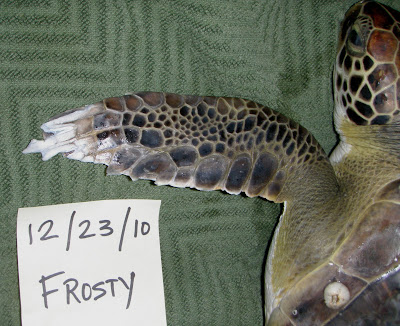For our last entry in the environmental enrichment blog series, we would like to show you how sea turtles scratch their shells in the Aquarium's Sea Turtle Hospital. Since we are unable to provide rocky ledges and coral reefs in the hospital tanks, we build square PVC structures that hang in the water column for sea turtles to use as backscratchers. The green sea turtles are especially fond of the PVC backscratchers, although some didn’t read the instruction manual and use it to sleep on top of like 18th Green below!
There is no room in Frosty's tank section to hang a backscratcher so "he" uses the filter return pipe to scratch his shell.
We have found that the loggerhead and Kemp's ridley sea turtles are much less likely to use the backscratchers the way the greens do (although they do use them in other ways). They enjoy other types of shell stimulation such as water pouring into their tanks and scrub brushes. The next video is the Kemp's ridley, Little Debbie, enjoying a back scrub.
This concludes the sea turtle enrichment blog series from the South Carolina Aquarium Sea Turtle Rescue Program. We hope you have enjoyed it as much as we enjoyed putting it together! If you visit the Sea Turtle Hospital, let us know that you that you saw the enrichment blogs so we can show you some of this enrichment in person. All tour days and times are on the main hospital page. We hope to see you soon!
Megan and Kelly






















 The next image is a striking comparison of the flipper from photographs taken on January 5 and February 9. During this time, Frosty's appetite and behavior have improved drastically. Bloodwork has improved, as well. Great progress!
The next image is a striking comparison of the flipper from photographs taken on January 5 and February 9. During this time, Frosty's appetite and behavior have improved drastically. Bloodwork has improved, as well. Great progress!
 Cathedral Academy students, parents and teachers, visited the Sea Turtle Hospital armed with beautiful, homemade, get well cards and much needed hospital supplies such as trash bags, sponges and dish soap.
Cathedral Academy students, parents and teachers, visited the Sea Turtle Hospital armed with beautiful, homemade, get well cards and much needed hospital supplies such as trash bags, sponges and dish soap.
 It was obvious that a great deal of time, effort and love went into each and every card. The covers were sparkling and creative, and inside contained personal messages and poems to the patients. Each child was thrilled to meet the turtle whose card he or she had worked so hard to create. It was a wonderful tour with kids very excited about helping sea turtles.
It was obvious that a great deal of time, effort and love went into each and every card. The covers were sparkling and creative, and inside contained personal messages and poems to the patients. Each child was thrilled to meet the turtle whose card he or she had worked so hard to create. It was a wonderful tour with kids very excited about helping sea turtles.